Saddle Theory: Part II
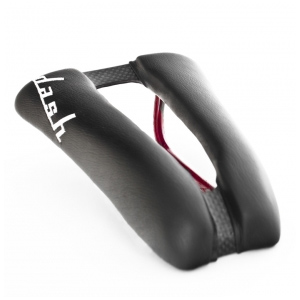
There's a Part I to this series, in case you're arriving late to the party. In the introduction I recount some history to bike saddle design, according to my recollection and experience.
And experience is one thing my keister has, as it has been aboard a bike saddle avidly and competitively for part or all of the past 5 decades (I started cycling contemporaneously with the release of Frampton Comes Alive).
Road cycling has changed a lot since then, and then again it hasn't. I ride my road bike today precisely, and exactly, the way I rode it while humming Show Me The Way with two exceptions: I don't reach to the down tube to shift, and then there's the pedals.
There have been four game changers in road bike design since I commenced cycling: click shifting and integrated shift/brake levers are two of them.
The third is pedal float. This is the single technology, during my 35-year tenure as a cyclist, that actually changes how the body moves during the act of riding a road bike.
The fourth game changer you can imagine. The aerobar represented an enormous departure from cycling prior to that moment. I'm convinced not even those involved in the early design of the bars—Boone Lennon, Richard Bryne, Pete Penseyres—understood that this was not a new road bike peripheral, rather it was the start of a new style of bicycle entirely. The first time Steve Hed ever saw the Scott DH aerobar mounted on a road bike he remarked, "It's now a front recumbent." And he was right.
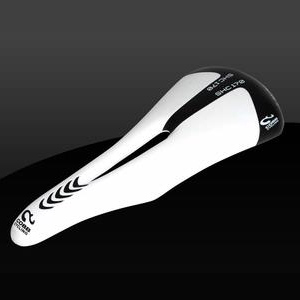
Why this segue? Because it's important you understand that you must reexamine everything you think you know about bicycle fit, tactics, technique, and technology when you bolt aerobars onto a bike. Certainly there are a lot of things about both road and tri that are quite similar, but you can't take anything about road cycling—gearing, geometry, fit coordinates, crank length, wheelsize, tactics, cadence, pedaling action, even your choice of apparel, helmet, sunglass—and just transfer it to tri bike riding without first examining whether there exists a precise symmetry between the two activities.
Are there differences between how you sit, and what you do, aboard a saddle on a road bike versus a tri bike? Yes. Two differences, and they're big.
During the discussion of tri versus road bike fit, have you ever heard a reference to rotating one's body around the face of a clock? This is symbolism often used. If you can imagine, from the drive side, a body rotated, in place, clockwise, this describes the rotating of a person from 73 degrees to 79 degrees of seat angle, with a corresponding flattening of the back, keeping the hip angle relatively unchanged. This is a simple way of portraying the shift from road to tri.
In fact, this happened on road race bikes already, before the advent of the aerobar or the tri bike. The shift from seated climbing, hands-on-tops to the "neutral" position, hands-on-hoods to the on-the-rivet position, hands-on-drops is a way road cyclists rotate around the face of the clock without ever changing bikes. To do this, you must of course utilize the entire range of the saddle, front-to-back.
What makes this possible? Handlebar design. Because road bars offer three (at least) distinct hand positions—tops, hoods and drops—road bikes are elegantly designed to allow for a multitude of seated rider positions (not to mention the unseated positions).
Not so tri bikes. They really only allow for one optimized position. Once you're out of the aero position, you're pretty much toast if speed is your aim, unless you have an eminently defensible reason for being out of the aero position (braking, for example).
Those who ride tri and TT bikes therefore should not use, and do not need, the length of the saddle, front to rear. Further, they are specifically encumbered by the flanges of the saddle. Referring back to the face-of-the-clock analogy, if you are so-rotated, your tibias tend not to pump up and down, rather they're now trending down and back during the downstroke. This means the femur makes more of a pendular motion, sweeping back against the saddle, and flanges impede this movement.
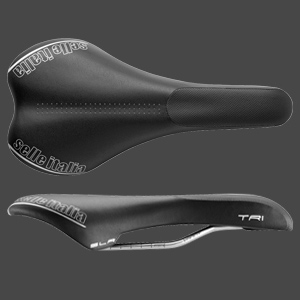
The epitomy of minimalism in tri saddles are the Tri.7 and TT.9 made by Dash Cycles. No flange. Very short. The Tri.7 is pictured at the top of this page.
There is not an entire lack of fore/aft movement on the saddle while on a tri bike. But if I were to take a rough guess I'd say it's about half of what exists on the saddle of a road race bike. Accordingly, saddle makers who wisely design for tri start with a shell that's flat. The very feature popular among road saddles that I'm less enamored with—flat shells, front-to-rear—I love when designing a tri saddle. There's no reason for the lip in the back of a tri saddle, because, the need to keep oneself from sliding backward during climbing is less evident on a tri bike.
Furthermore, because tri saddles are flat or very slightly nosed down, if one moves to the back of the saddle—lip or no lip—the resulting distance from saddle to pedal is so long as to render the leg length untenably long.
The important elements of tri bike saddle shell shape are: flat across the top in each axis: front-to-back, and side-to-side; a long "nose" before the saddle widens out via its flanges (or, even a lack of fully vested flanges). A good example of this is John Cobb's SHC (pictured next down from the top). This saddle may or may not be the saddle in the Cobb line that you'll find most comfortable (many prefer Cobb's more padded saddles, like the Max, which also features narrow flanges). But it's the perfect execution of flange width reduction.
An example of a saddle that incorporates most of these features is the Selle Italia SLR Tri Gel (pictured third from top). It's flat front to back, left to right, and as long as you don't move to the back of the saddle the flanges don't get in your way. Note that what makes the SLR and the Fi'zi:k Arione great shells—bases—for tri saddles is the very feature which I'm less enamored with when applied to road race saddles: a flat front-to-back aspect.
If you're riding a standard saddle—rather than a split nose saddle like a Dash Tri.7 or an ISM Adamo—Koobi, SMP and the like are in a different category of split nose saddle—you'll need to decide whether you like a lot of padding or whether you're more of a minimalist. I don't know any good way of helping you determine what style you'll prefer.
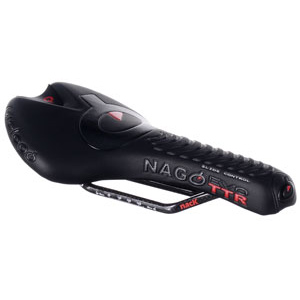
Saddles with a lot of gel and padding in the nose—such as Profile Design's Tristryke—will leave you feeling less stable, or attached, to the bike because you're floating atop the saddle's shell. When I first boarded this saddle I remember that it felt a bit like first getting on pedals with float, back in the 1980s. It was strange getting used to that lack of structure. It's also slightly reminiscent of first getting aboard a Softride bike with the original beam. It's an acquired taste (but the TriStryke is a taste I did acquire).
Other saddles—the Fi'zi:k Arione Tri 2 is an example—is minimalist on the nose compared to the TriStryke, even though the saddle sports more padding than the original Arione. I rather like the Arione Tri 2 as a road saddle over the road Arione.
I'm leaving all split rail saddles for a future chapter in this series. There is one more thing about typical or conventional saddle designs built for tri that should be mentioned, and that is saddle tilt. One nice feature of certain saddles is an upper that is specifically not slick. While a slick upper may be of value in certain road saddles, the ability to stick to a spot on the saddle allows some amount of downward tilt in the nose.
There are a couple of ways to do this. The TriStryke has a lycra upper that is just not that slick, so, if you tilt the nose down 2 or 3 degrees you'll still stay put. If you look at Cobb's saddles and, to a much greater degree the Prologo Nago Evo TTR saddle (which I notice as of this writing is half off at Competitive Cyclist, and which is pictured just above), you'll see some "speed bumps" designed specifically to keep your trunk in place. This does allow you to tilt the nose down a bit if that solves point tenderness problems.
Realize that there's a limit to the downward tilt of the nose, and that limit is where you start to slide off the front of the saddle. When you need to push yourself back up onto the saddle with every pedal stroke, you've gone too far. Unless your trunk naturally sticks to its spot in the saddle you're tilted down too far. That point is, on average, when the nose is tilted down more than 3 degrees. If you place a short level (like a line level) on the nose, and measure the downward tilt, you can make sure you're not overdoing it. But the ultimate test is in the riding: Your Keister, like the Dude, abides rather than slides.
"But a greater downward tilt is the only way I can find comfort!" you say. I feel your pain. Well, actually, no, I don't feel your pain. Because I've taken the time to find the saddle that's right for me. If a steep downward tilt in the nose is your only pathway to comfort, it just means you're on the wrong saddle. Find one that you don't have to tilt so much. It's out there somewhere.


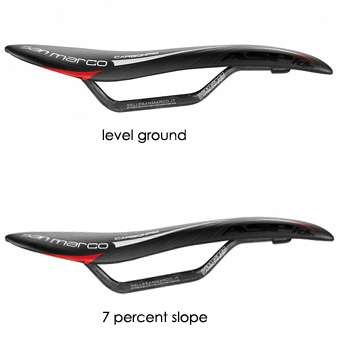
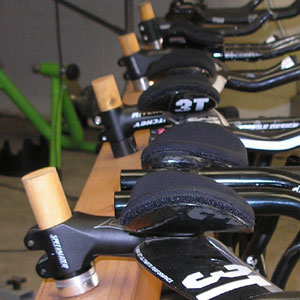
Start the discussion at slowtwitch.northend.network